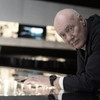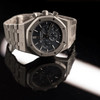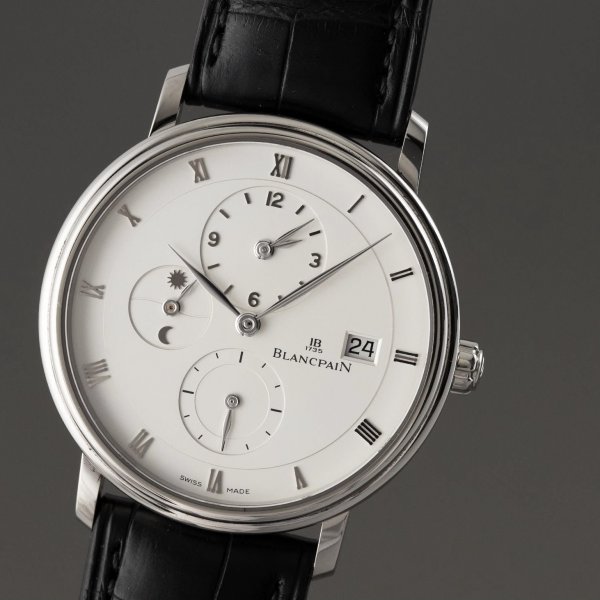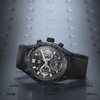

J.C. Biver: The world belongs to those who are not afraid
Opinions on Jean-Claude Biver vary, but everyone agrees that he is one of the most prominent figures in the watchmaking industry, and learning about his career is a must for every watch and marketing enthusiast.
In the past, I wrote an article about TAG Heuer's journey to the Tourbillon and how Jean-Claude Biver completed it. That's why I decided to write a separate article about him and my view of him.
Jean-Claude Biver (aka JCB) was born in Luxembourg in 1949. He later studied in Lausanne and began his career at Audemars Piguet.

Audemar Piguet (AP)
JCB originally worked for Audemars Piguet, which he joined in 1974 and was put in charge of the European market. He joined the company essentially two years after the launch of the Royal Oak model (in 1972), but as he himself said, at that time no one even suspected that steel watches would evoke such strong emotions. His beginnings were quite unusual, because when he joined the company, he was only paid half his salary. When he asked why this was the case, he was told that in order to work, he first had to learn. In order to learn, he would pay the company the other half of his salary.

Blancpain
After leaving AP in 1982, JCB and his friend Jacques Piguet decided to buy the license for the defunct Blancpain brand, which, I should point out, had never been a prestigious one. Blancpain had been a defunct company since the late 1960s, with no drawings or plans for watches, or even tools for manufacturing them. Therefore, it was necessary to start from scratch. Jacques Piguet owned the Frédéric Piguet factory for the production of mechanical calibers. Blancpain was owned by Omega and was willing to sell the license for approximately 22,000 Swiss francs.
Personally, when choosing a watch, I consider several factors, such as consistency, continuous production, and innovation across decades. But the overall influence of the brand on the industry also has a significant impact on the final decision. Nevertheless, I really like Blancpain, and the Aqualung Grande Date is one of my favorites.
JCB decided that Blancpain would produce only mechanical watches and nothing else, and even based its entire marketing strategy on this. That would have been fine, but in 1982, the great quartz crisis was at its peak, the vast majority of the watch industry was on its knees, and brands such as Patek and Rolex were making various battery-powered variations. Despite all this, "some guy" named Biver said that he would only make mechanical watches anyway. This was also the central point of the anti-quartz campaign. He sold his watches as pieces of art, not ridiculous battery-powered watches—accurate, but ridiculous. As they say, "the world belongs to those who are not afraid" (Charles Bukowski's version was a little more vulgar). Blancpain began selling watches in 1983 and two years later had a turnover of 8.9 million Swiss francs. Later, in 1992, the company achieved an astronomical turnover of 50 million. The Swatch Group's purchase of the company for 60 million francs was not long in coming. Once again, they bought the license for 22,000!

Omega
After exceptional success at Blancpain, JCB moved to Omega, where it once again demonstrated its mastery by linking Omega with Her Majesty's agent James Bond (1995 Golden Eye). So yes, this is when watch product placement in movies began. During JCB's tenure, ambassadors such as Cindy Crawford and other celebrities joined the company, which significantly helped Omega. At that time, Omega was not what it is today. I also wrote about the legendary connection between Omega and James Bond, which you will learn about soon.
Hublot
JCB started at Hublot in 2004, at a time when the company was already facing existential problems. The bland company, founded in 1980, had trouble establishing itself. Then, in 2005, the legendary BIG BANG model was created. Although many people criticized Biver and those around him for the watch's striking resemblance to the AP Royal Oak, he simply replied: "So what?" I really like another story about how Biver came to Hublot and asked the employees at a meeting to tell him one bad thing they had done so far, and everyone was silent. He came back a second time and said: "Tell me at least one thing or idea that you think was bad." No one said anything, again silence. The third time, he called the cashier and said, "Whoever tells me one decision they think was bad will get a thousand francs in cash with no personal consequences."
Suddenly, one person spoke up and said, "We have more than 70,000 bags in stock and we pay for a couple of warehouses, even though our annual production is 7,000 pieces." But what was more important, in my opinion, was how JCB approached the marketing of the new model. It took the watch, found a famous soccer player, and put the watch on his wrist. At the time, everyone condemned it, because soccer is a sport for the masses, even the poor can watch soccer... But it saw great potential in soccer, and it was right.
He was also the first to agree to collaborate with Usain Bolt. For the first time in watch marketing, an athlete with a skin color other than white appeared. nbsp;Over time, the media began to take an interest in soccer players, and when the media took an interest in soccer players, they also took an interest in their wives, cars, and, of course, watches. So what kind of watches did soccer players wear? I dare say that if it weren't for JCB, Hublot probably wouldn't be where it is today.

TAG Heuer 2014 - 2018
JCB later became CEO of TAG Heuer, where he pushed for the Haute Horlogerie project to be discontinued. This was the division of TAG Heuer responsible for projects such as Micrograph, a watch with a mechanical movement capable of measuring 1/100 of a second, priced at around €37,000, and Monaco V4, which used a revolutionary belt drive system and was priced at €96,000. It sounds strange, but the point was that he did not think it was normal for a company producing watches with an average price of €4,000 to also produce expensive and unaffordable watches. So JCB teamed up with a guy named Guy Sémon (a French designer of military flight simulators) and the director of the former Haute Horlogerie department, who had been with TAG Heuer since 2004, and began working on merging high watchmaking with the standard collection. The first result of this collaboration was the HEUER 02T – the cheapest Swiss tourbillon in the world. You can read more about TAG Heuer's journey to the Tourbillon in a separate article.
Although Jean-Claude Biver, JCB, is a big star in the Swiss watchmaking world for me, not everyone agrees with me. Thanks to my work, I have had the opportunity to travel regularly to Switzerland, where I have often learned behind-the-scenes information that should remain under wraps and brings a lot of mystery and excitement to this world. However, the truth is that many people viewed Biver's arrival at TAG Heuer rather negatively. As I mentioned in my previous article, Jean Christophe Babin had been the CEO of TAG Heuer since 2000. He came from Henkel, so he didn't have much experience with watches—let alone the luxury segment.
But Babin went around asking people for advice, consulting with them, and even very often with Jack Heuer. The results were not long in coming, and I would venture to say that it was he who defined the contours of TAG Heuer as we know it today. nbsp;When Biver joined the company, it was no longer the same formula as in the past, when it was necessary to start companies on the brink of existential problems. TAG Heuer was already a mega-company whose turnover was declining year-on-year but still managed to make more than 100 million francs. JCB came to bring a breath of fresh air. However, as I heard, he arrived as a star of the highest rank with an ego bigger than the Apennine Peninsula and made changes from the ground up. Allegedly, this was because he didn't like Babin very much. In other words, whatever Babin did, JCB did the opposite.
The first step under Biver's leadership was the project to launch the HEUER 01 caliber, but as you know, it was only an evolution of the CH80 movement, which was developed under Babin's leadership, and the creation of the Tourbillon (you can read about it here). nbsp;He more or less took over the case from Hublot, which is why 2015 is considered the biggest milestone in terms of the brand's design. Although the Tourbillon was created in 2016, we ordered a large number of pieces, but we didn't receive a single one in a year. When JCB left, he dissolved the high watchmaking department and, along with it, let go of a huge number of skilled watchmakers who knew how to assemble the Tourbillon. And you won't easily find a watchmaker who can do that on the street.
So Bivier made a big show around the Tourbillon, orders came in from all over the world, but there was no one in Switzerland to assemble the Tourbillon. It is said that this was due to his huge ego or because he was losing steam. Either way, I am very happy that TAG Heuer is returning to its roots. Jean-Claude Biver is no longer part of TAG Heuer. Until 2018, he was the CEO of TAG Heuer and president of the watch division of the LVMH group, where he was responsible for TAG, Zenith, and Hublot.
In conclusion, I would just like to add that, regardless of what I think about his work at TAG Heuer, the truth is that he is still one of the greatest personalities I have ever had the opportunity to meet in person. His impact on watchmaking is enormous, especially in terms of the perception of watches not only as technical objects made of metal and gears, but also as objects of passion. I recommend watching at least one video or interview with him.
I will never forget meeting him at Baselworld, where he was running between Hublot, Zenith, and TAG Heuer, but so as not to offend anyone, he was still wearing Patek Philippe—his arch enemy, whom he had always wanted to defeat since his days at Audemars Piguet.
INTRODUCTION
My name is Martin Demko and I have been working with watches since 2011. During that time, I have handled many models: cheap ones, expensive ones, renowned brands, and lesser-known ones. My work is both a pleasure and a hobby for me. What I have always strived for and continue to strive for is maximum honesty towards customers, even at the expense of business. I have completed numerous training courses and a relatively large number of training sessions in Switzerland. If you like my articles and my subjective view on individual topics, or if you disagree, feel free to write to me at m.demko@wdl.sk. I would really appreciate any feedback.








